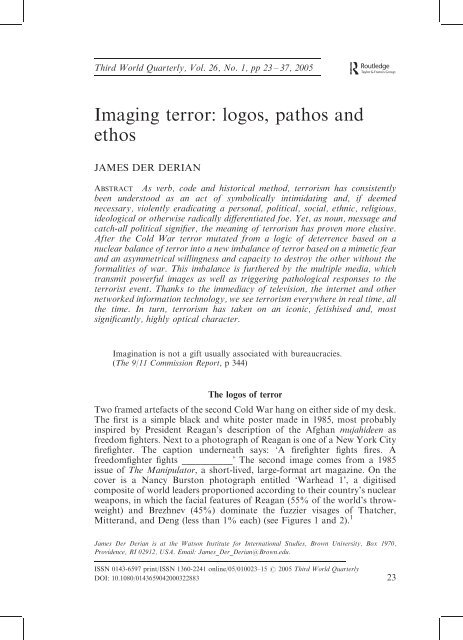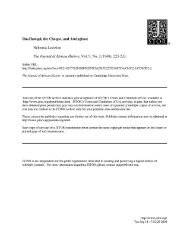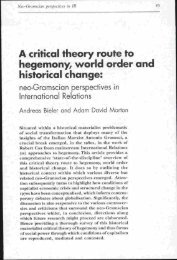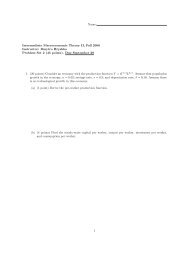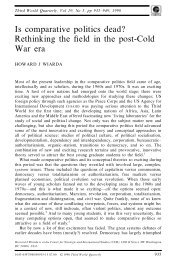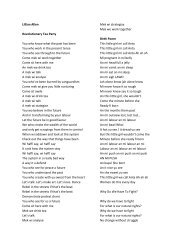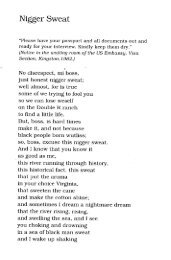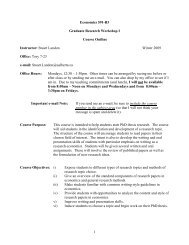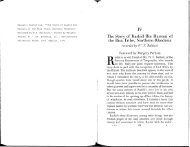Imaging terror: logos, pathos and ethos
Imaging terror: logos, pathos and ethos
Imaging terror: logos, pathos and ethos
Create successful ePaper yourself
Turn your PDF publications into a flip-book with our unique Google optimized e-Paper software.
Third World Quarterly, Vol. 26, No. 1, pp 23 – 37, 2005<br />
<strong>Imaging</strong> <strong>terror</strong>: <strong>logos</strong>, <strong>pathos</strong> <strong>and</strong><br />
<strong>ethos</strong><br />
JAMES DER DERIAN<br />
ABSTRACT As verb, code <strong>and</strong> historical method, <strong>terror</strong>ism has consistently<br />
been understood as an act of symbolically intimidating <strong>and</strong>, if deemed<br />
necessary, violently eradicating a personal, political, social, ethnic, religious,<br />
ideological or otherwise radically differentiated foe. Yet, as noun, message <strong>and</strong><br />
catch-all political signifier, the meaning of <strong>terror</strong>ism has proven more elusive.<br />
After the Cold War <strong>terror</strong> mutated from a logic of deterrence based on a<br />
nuclear balance of <strong>terror</strong> into a new imbalance of <strong>terror</strong> based on a mimetic fear<br />
<strong>and</strong> an asymmetrical willingness <strong>and</strong> capacity to destroy the other without the<br />
formalities of war. This imbalance is furthered by the multiple media, which<br />
transmit powerful images as well as triggering pathological responses to the<br />
<strong>terror</strong>ist event. Thanks to the immediacy of television, the internet <strong>and</strong> other<br />
networked information technology, we see <strong>terror</strong>ism everywhere in real time, all<br />
the time. In turn, <strong>terror</strong>ism has taken on an iconic, fetishised <strong>and</strong>, most<br />
significantly, highly optical character.<br />
Imagination is not a gift usually associated with bureaucracies.<br />
(The 9/11 Commission Report, p 344)<br />
The <strong>logos</strong> of <strong>terror</strong><br />
Two framed artefacts of the second Cold War hang on either side of my desk.<br />
The first is a simple black <strong>and</strong> white poster made in 1985, most probably<br />
inspired by President Reagan’s description of the Afghan mujahideen as<br />
freedom fighters. Next to a photograph of Reagan is one of a New York City<br />
firefighter. The caption underneath says: ‘A firefighter fights fires. A<br />
freedomfighter fights ___________’ The second image comes from a 1985<br />
issue of The Manipulator, a short-lived, large-format art magazine. On the<br />
cover is a Nancy Burston photograph entitled ‘Warhead 1’, a digitised<br />
composite of world leaders proportioned according to their country’s nuclear<br />
weapons, in which the facial features of Reagan (55% of the world’s throwweight)<br />
<strong>and</strong> Brezhnev (45%) dominate the fuzzier visages of Thatcher,<br />
Mitter<strong>and</strong>, <strong>and</strong> Deng (less than 1% each) (see Figures 1 <strong>and</strong> 2). 1<br />
James Der Derian is at the Watson Institute for International Studies, Brown University, Box 1970,<br />
Providence, RI 02912, USA. Email: James_Der_Derian@Brown.edu.<br />
ISSN 0143-6597 print/ISSN 1360-2241 online/05/010023–15 # 2005 Third World Quarterly<br />
DOI: 10.1080/0143659042000322883 23
JAMES DER DERIAN<br />
FIGURE 1.<br />
Warhead 1.<br />
These two images speak volumes, revealing the grammatical <strong>logos</strong> that<br />
underwrites the <strong>pathos</strong> <strong>and</strong> <strong>ethos</strong> of <strong>terror</strong>. As verb, code <strong>and</strong> historical<br />
method, <strong>terror</strong>ism has consistently been understood as an act of symbolically<br />
intimidating <strong>and</strong>, if deemed necessary, violently eradicating a personal,<br />
political, social, ethnic, religious, ideological or otherwise radically differentiated<br />
foe. Yet, as noun, message <strong>and</strong> catch-all political signifier, the meaning<br />
of <strong>terror</strong>ism has proven more elusive. From Robespierre’s endorsement to<br />
Burke’s condemnation during the French Revolution, from the Jewish Irgun<br />
blowing up the King David Hotel to the Palestinian Black September massacre<br />
at the Munich Olympics, from Bin Laden the Good fighting the Soviet<br />
24
IMAGING TERROR<br />
FIGURE 2.<br />
Reflections on Terrorism.<br />
occupiers of Afghanistan to Bin Laden the Bad toppling the Twin Towers of<br />
New York, <strong>terror</strong>ism, <strong>terror</strong>ists <strong>and</strong> <strong>terror</strong> itself have become the political<br />
pornography of modernity: one knows <strong>terror</strong>ism with certainty only when,<br />
literally, one sees it. But, in the blink of an eye, the <strong>terror</strong>ist can become the<br />
freedom fighter, <strong>and</strong> vice versa, for at one time or another nearly everyone,<br />
from righteous statesmen who <strong>terror</strong>-bomb cities to virtuous jihadists who<br />
suicide-bomb women <strong>and</strong> children, seems to have a taste for <strong>terror</strong>.<br />
Without engaging in nostalgia, one can recognise that the most powerful<br />
form of <strong>terror</strong> mutated at the end of the Cold War. With the decline (if not<br />
25
JAMES DER DERIAN<br />
the total demise) of a logic of deterrence based on a nuclear balance of <strong>terror</strong>,<br />
so too eroded the willingness <strong>and</strong> capacity to inflict mutually unacceptable<br />
harm that had provided a modicum of order, if not peace or justice, to the<br />
bipolar system. In its place a new imbalance of <strong>terror</strong> has emerged, based on a<br />
mimetic fear <strong>and</strong> hatred coupled with an asymmetrical willingness <strong>and</strong><br />
capacity to destroy the other without the formalities of war. 2 This cannot be<br />
reduced, as much as leaders on both sides of the conflict have tried, to a post-<br />
9/ll phenomenon. It can be traced back doctrinally to the 1990’s, when a<br />
series of US defense policy guidances (subsequently formalized in the 1997<br />
Quadrennial Defense) shifted US strategy from collectively deterring <strong>and</strong><br />
dominating to unilaterally <strong>and</strong> preemptively destroying the enemy, <strong>and</strong> when<br />
Bin Laden issued his pseudo-fatwas which decreed Christian <strong>and</strong> Jewish<br />
civilians legitimate targets of the jihad.<br />
As in the older, tidier balance of <strong>terror</strong>, the doctrine of taking civilians<br />
hostage <strong>and</strong> if necessary killing them still held for both sides, but it now<br />
operated as a contingent factor of an asymmetrical relationship. Regardless of<br />
nomenclature—‘<strong>terror</strong>’ or ‘counter-<strong>terror</strong>’—high numbers of civilians would<br />
(<strong>and</strong> continue to) be killed in the process. It might be small solace to the<br />
victims to know they were primary targets as opposed to ‘accidental’ or<br />
‘collateral’ victims, especially since casualty rates have been terribly skewed in<br />
both cases. When one takes into account how war-related fatalities have been<br />
reversed in modern times, from 100 years ago when one civilian was killed per<br />
eight soldiers, to the current ratio of eight civilians per soldier killed, then<br />
compares the similarly-skewed combatant-to-non-combatant casualty figures<br />
of 9/11, the Afghan War, <strong>and</strong> the Iraq War, the <strong>terror</strong>/counter-<strong>terror</strong><br />
distinction begins to fade even further. Perhaps it is time for a new Burson<br />
composite, using the leaders of the three conflicts to proportionally represent<br />
the number of civilian casualties from the three conflicts.<br />
With weapons systems, war-fighting doctrine <strong>and</strong> war games often<br />
wagging the dog of civilian policy, the narratives as well as the paladins of<br />
the Cold War seem destined to an eternal return in US foreign policy. Having<br />
mapped this phenomenon before 9/11, I wish to focus on what (if anything)<br />
has changed since then, <strong>and</strong> to underst<strong>and</strong> the celerity <strong>and</strong> alacrity by which<br />
our age has now been defined by <strong>terror</strong>ism. 3 Although the fundamentalist<br />
religious <strong>and</strong> political beliefs of the major combatants have attracted the<br />
most attention, I think we need to pay more attention to the multiple media,<br />
which transmit powerful images as well as help to trigger highly emotional<br />
responses to the <strong>terror</strong>ist event. Thanks to the immediacy of television, the<br />
internet <strong>and</strong> other networked information technology, we see <strong>terror</strong>ism<br />
everywhere in real time, all the time. In turn, <strong>terror</strong>ism has taken on an<br />
iconic, fetishised <strong>and</strong>, most significantly, a highly optical character. After<br />
witnessing the televised images of kamikaze planes hitting the World Trade<br />
Center, the home videos of Bin Laden, the internet beheading of Nicholas<br />
Berg, we were all too ready to agree with President Bush: ‘Evil now has a<br />
face’.<br />
However, somewhere between the Pyrrhic victory of Tora Bora <strong>and</strong> the<br />
disastrous post-war of Iraq, the face of <strong>terror</strong> began to morph into a new<br />
26
IMAGING TERROR<br />
Post-Bursonian composite. The ‘<strong>terror</strong>ist’ can now easily do double-duty as<br />
an airport security profile, featuring the checkered keffiyeh of Arafat, the<br />
aquiline nose of Osama Bin Laden, the hollowed face of John Walker Lindh,<br />
the maniacal grin of Saddam Hussein, the piercing eyes of Abu Musab<br />
Zarqawi (‘He could direct his men simply by moving his eyes’, said Basil Abu<br />
Sabha, his Jordanian prison doctor). The historicity, specificity <strong>and</strong> even the<br />
comprehensibility of <strong>terror</strong>ism have been transmogrified by the new holy <strong>and</strong><br />
media wars into a single physiognomy of global <strong>terror</strong>.<br />
Of course, our image of <strong>terror</strong> did not arrive by itself or on its own. Just<br />
as every image comes with an explicit or implicit caption—what Rol<strong>and</strong><br />
Barthes, the gifted semiotician, referred to as the ‘anchorage’ which seeks to<br />
fix the ‘polysemy’ of the sign 4 —so too is the war on <strong>terror</strong> freighted with<br />
the narratives of the Cold War. Moreover, the legacy of the Cold War lives<br />
on through popular culture, a ‘fact’ ably noted by a Hollywood actor who<br />
knows a thing or two about the morbidity of comebacks. Playing a ‘Cfuckin’-I-A<br />
agent’ doubling as a Gulf war arms dealer, up against FBI<br />
straight man (another constant in national security culture) Willem Dafoe,<br />
Mickey Rourke colourfully notes how the dead continue to weigh on the<br />
living:<br />
This isn’t about sides. This is about confusion. This is about creating enemies<br />
when there aren’t any. And, man, the whole Goddamn world’s falling apart.<br />
Peace reigns, freedom reigns, democracy rules. How are we gonna keep the<br />
military – industrial complex chugging forward without clear-cut, pit-faced,<br />
scum-sucking evil breathing down our neck? Hmmm? Threatening our very<br />
shores. Now my job is to make sure the other side keeps fighting; whatever<br />
side—I mean whatever side we’re officially not on this year. 5<br />
Seen in this light, the war on <strong>terror</strong> is not new but part of a permanent state<br />
of war by which the sovereignty of the most powerful state is reconstituted<br />
through the naming of <strong>terror</strong>ist foe <strong>and</strong> anti-<strong>terror</strong>ist friend.<br />
There are lessons to be learned from an earlier inter-war—one that is<br />
beginning to look too much like our own—in which two media critics, avant<br />
la lettre, first confronted this new matrix of art, politics <strong>and</strong> <strong>terror</strong>. Walter<br />
Benjamin took his first measure of film production in his celebrated essay,<br />
‘The Work of Art in the Age of Mechanical Reproduction’, taking note of<br />
how mechanically reproduced art, especially film, could be especially useful<br />
to, if not generative of, fascism. Rendering politics into aesthetics had the<br />
advantage of mobilising the masses for war without endangering traditional<br />
property relations. He quotes the futurist Marinetti to chilling effect:<br />
War is beautiful because it establishes man’s dominion over the subjugated<br />
machinery by means of gas masks, terrifying megaphones, flame throwers, <strong>and</strong><br />
small tanks. War is beautiful because it initiates the dreamt-of metalization of<br />
the human body. . .War is beautiful because it creates new architecture, like that<br />
of the big tanks, the geometrical formation flights, the smoke spirals from<br />
burning villages, <strong>and</strong> many others. . .Poets <strong>and</strong> artists of Futurism!. . .remember<br />
these principles of an aesthetics of war so that your struggle for a new literature<br />
<strong>and</strong> a new graphic art. . .may be illumined by them! 6<br />
27
JAMES DER DERIAN<br />
The aesthetic of the reproducible image overpowered the aura <strong>and</strong><br />
authenticity of the original. In The Arcades Project Walter Benjamin studied<br />
the significance of this new development for the Rankean realism that<br />
hitherto had underwritten much of geopolitical discourse. ‘The history that<br />
showed things ‘‘as they really were’’ was the strongest narcotic of the<br />
century.’ He went on to declare that ‘history decays into images, not into<br />
stories’. Benjamin defined an image as ‘that wherein what has been comes<br />
together in a flash with the now to form a constellation’; or, as he more<br />
simply put it, images are ‘dialectics at a st<strong>and</strong>still’. 7 I believe his endorsement<br />
of a counter-medium, the use of montage as ‘the art of citing without<br />
quotation’, in which ‘truth is charged to the bursting point with time’, has<br />
become just as valid for our own times.<br />
Also writing in Germany in the inter-war period, <strong>and</strong> trying to underst<strong>and</strong><br />
the immense popularity of Berlin’s new picture palaces, Siegfried Kracauer<br />
thought the Berliners had become ‘addicted to distraction’. He called them<br />
‘optical fairyl<strong>and</strong>s’—‘to call them movie theaters’, he said, ‘would be<br />
disrespectful’—where ‘distraction—which is meaningful only as improvisation,<br />
as reflection of the uncontrolled anarchy of the world—is festooned<br />
with drapes <strong>and</strong> forced back into a unity that no longer exists’. In Kracauer’s<br />
view the picture palaces served as a kind of Hegelian asylum from Weimar<br />
disorder, ornate spaces where the alienated Berliner could seek reunification<br />
through what he called a ‘cult of distraction’. Substitute Fox, CNN, MSNBC<br />
for the picture palace, <strong>and</strong> we find another potential guide for leading us<br />
through an ‘Age of Info-<strong>terror</strong>’.<br />
The <strong>pathos</strong> of <strong>terror</strong><br />
We ‘moderns’ might now recognise the increasing power of images over<br />
words, but we have been slower to underst<strong>and</strong> the consequences, as they have<br />
increasingly taken on a pathological character, for the war on <strong>terror</strong>. How<br />
might we read, in the spirit of Benjamin <strong>and</strong> Kracauer, the Bin Laden videos<br />
as well as the official response to them?<br />
At first viewing the Bin Laden home videos underst<strong>and</strong>ably yielded a<br />
fairly uniform <strong>and</strong> deserved response of outrage in the USA <strong>and</strong> Europe.<br />
However, not just in the Middle East but in parts of America with large<br />
Arab populations, like Dearborn, MI <strong>and</strong> Los Angeles, questions were<br />
soon raised about their authenticity. The doubts can be understood in<br />
Benjamin’s terms, of the loss of aura from the original produced by<br />
technical reproducibility, but multiplied many times by the convergence of<br />
the Ages of Terror <strong>and</strong> Adobe Photoshop, or what I have referred to as the<br />
Age of Info-<strong>terror</strong>. 8 It reflects as well an increasingly global view that<br />
Hollywood, Silicon Valley <strong>and</strong> Washington, DC have joined forces in the<br />
war on <strong>terror</strong>.<br />
For those who might detect a whiff of conspiracy in such claims, a short<br />
history of events after 9/11 might be instructive. By early October 2001<br />
White House advisers had already begun a series of meetings with directors,<br />
producers <strong>and</strong> executives from the entertainment industry on how Holly-<br />
28
IMAGING TERROR<br />
wood might best help the war effort. To be sure, an alliance between the<br />
military <strong>and</strong> the entertainment industry was not entirely new. The mixing of<br />
spectacle <strong>and</strong> war goes back to the beginnings of film, when DW Griffith,<br />
already famous for his 1915 Birth of the Nation, went to work for Lord<br />
Beaverbrook’s War Office in World War I. However, there was some cause<br />
for worry with this new overture. My own concern was first triggered at the<br />
opening of the innocuous-sounding Institute for Creative Technologies<br />
(ICT), which I covered for Wired magazine in 1999. The ICT was set up at<br />
the University of Southern California to spearhead a remarkable project:<br />
with $43 million provided by the US Army it would combine the virtual<br />
reality tools of Silicon Valley <strong>and</strong> the talent of Hollywood film studios to<br />
produce state-of-the-art military simulations for future war. On the day of<br />
the opening one speaker after another, from the Secretary of the Army to<br />
the Governor of California, spoke of ‘making the quantum leap to the<br />
Army After Next’; ‘creating virtual environments for total immersion of<br />
participants’; <strong>and</strong>, my favourite, ‘engrossing stories stocked with emotional<br />
characters who may either be simulated or manned’, Jack Valenti, head of<br />
the Motion Picture Association, opened his remarks by correcting a<br />
previous speaker: ‘Los Angeles is not the ‘‘entertainment capital of the<br />
world’’ [pause], Washington, DC is the entertainment capital of the world<br />
[laughter].’<br />
I expressed my concern at the opening ceremony in the form of a question<br />
to Steven Sample, President of University of Southern California (USC):<br />
might not the linking up of Hollywood <strong>and</strong> the Pentagon repeat the World<br />
War II experience, when training films were mixed with propag<strong>and</strong>a films,<br />
<strong>and</strong> military simulations became a tool for public dissimulations? Were there<br />
any ethical checks <strong>and</strong> balances to assure that the ICT would not produce<br />
something like Wag the Dog? President Sample deadpanned a nervous<br />
sideways look <strong>and</strong> said, ‘As Jack is coming up to respond to that. . ..’ But<br />
Sample chose to respond by going back to an earlier observation, that the ICT<br />
would develop ‘synthetic experiences so compelling that people will react as<br />
though they were real—a virtual reality of sensations <strong>and</strong> sights’. He went on<br />
to make a deft analogy to Plato’s poor opinion of the poets. Not actually<br />
using the word mimesis, he suggested as much was going on at the ICT: by<br />
performing the classical function of poetry <strong>and</strong> theatre—artistically <strong>and</strong><br />
dramatically mimicking reality for a higher purpose—it could not help but<br />
arouse anxieties about whose version of reality was the true one. The allegory<br />
of the cave lurked behind the curtains.<br />
Where Sample applied nuance, Jack Valenti chose pugnacity. Responding<br />
to my question he said: ‘I want to illuminate a central truth to the<br />
gentleman—everything leaks, in Hollywood, in Washington. There’s no way<br />
you can keep a secret. You can’t fool the people for very long.’ He then<br />
informed me that I needed to correct my ‘Copernican complex’. He<br />
contrasted my view to the decision to drop the atomic bomb on the<br />
Japanese. Some might have seen that as a ‘heartless <strong>and</strong> terrible thing to<br />
do. . .but not the 150 000 American boys whose lives would have been lost.<br />
This is a lesson in Philosophy 101 that I am giving to you right now.’<br />
29
JAMES DER DERIAN<br />
I came away with a different lesson. Valenti, like many in power today, are<br />
all too ready to drop the bomb on dissident viewpoints. Nonetheless, he was<br />
on target in one regard: what separates <strong>and</strong> elevates war above lesser,<br />
‘Copernican’ conceits is its intimate relationship to death. The dead body—<br />
on the battlefield, in the tomb of the unknown soldier, in the collective<br />
memory, even on the movie screen—is what gives war its special status. This<br />
fact can be censored, hidden in a body bag, air-brushed away, but it provides,<br />
even in its erasure, the corporeal gravitas of war. However, everything I<br />
witnessed that day at the ICT was dedicated to the disappearance of the body,<br />
the aestheticising of violence, the sanitisation of war: in other words, to<br />
everything we have seen implemented since 9/11.<br />
Barely a week after the <strong>terror</strong>ist attack, the ICT began to gather top talent<br />
from Hollywood to create possible <strong>terror</strong>ist scenarios that could then be<br />
played out in their Marina del Rey virtual reality facilities. Then Karl Rove,<br />
White House special adviser, travelled to Beverly Hills to discuss with the top<br />
ceos how Hollywood might provide talent <strong>and</strong> resources for the battle<br />
against <strong>terror</strong>ism. Among those reported as contributing to the virtual war<br />
effort were Die Hard screenwriter Steven E De Souza, Matrix special effects<br />
wizard, Paul Debevec <strong>and</strong> directors David Fincher (Fight Club), Spike Jonze<br />
(Being John Malkovich) <strong>and</strong> R<strong>and</strong>al Kleiser (Grease). Fans of Kleiser might<br />
wonder why his classic work, Honey I Blew Up the Kid (about an amateur<br />
physicist who turns his son into a giant) went unmentioned in the press<br />
releases. Was it proof that the US government might be embarrassed to have<br />
hooked up with B-list directors? Or was it part of an info-war campaign to<br />
keep the lid on ‘Operation Shrink Bin Laden Back to Size’? When holy war<br />
comes to Hollywood, the truth is hard to come by.<br />
As more Bin Laden tapes emerged there were calls for censorship,<br />
heightened threat levels, <strong>and</strong> a cottage industry of media critics. Debates<br />
continued to focus on whether the tapes were real or not, was he dead or alive<br />
<strong>and</strong> then, most ominously, on whether he had joined ranks with Saddam<br />
Hussein. Gone missing was any attempt to underst<strong>and</strong> why Bin Laden<br />
continued to comm<strong>and</strong> a global audience.<br />
After Al Jazeera broadcast the first videotape, National Security adviser<br />
Condoleeza Rice made personal calls to heads of the television networks,<br />
asking them to pre-screen <strong>and</strong> to consider editing Al-Qaeda videos for<br />
possible coded messages. Secretary of State Powell interpreted the February<br />
2002 audiotape as proof positive that Bin Laden had forged an alliance with<br />
Saddam Hussein. Yet the most significant <strong>and</strong> constant message, intended for<br />
the aggrieved <strong>and</strong> dispossessed in Islam, has remained, like Edgar Allan Poe’s<br />
purloined letter, out in the open, in plain sight, <strong>and</strong> peculiarly unnoticed. Bin<br />
Laden was adeptly using networked technology to disseminate a seductive<br />
message of prophecy, reciprocity <strong>and</strong> ultimate victory.<br />
Shortly after the bombing campaign began in Afghanistan, <strong>and</strong> Bin<br />
Laden delivered his first videotape as a counter air-strike to the USA, he<br />
spoke with his guest <strong>and</strong> camera crew of the many dreams that had<br />
preceded 9/11: of playing soccer games against American pilots, in which<br />
Al-Qaeda members become pilots themselves in order to defeat the<br />
30
IMAGING TERROR<br />
Americans; of a religious leader who dreamt of carrying a huge plane<br />
through the desert; of the wife of a jihadist who saw a plane crashing into<br />
a building a week before the event. An unidentified man off-camera<br />
interrupts bin Laden, saying that ‘Abd Al Rahman saw a vision before the<br />
operation, a plane crashed into a tall building, he knew nothing about it’.<br />
At this point Bin Laden turns to his guest <strong>and</strong> says: ‘I was worried that<br />
maybe the secret would be revealed if everyone starts seeing it in their<br />
dreams. So I closed the subject’. The koranic view of dreams as prophecy<br />
appeared to be taken so seriously that Bin Laden believed operational<br />
secrecy was at risk. For Bin Laden prophecy anticipates the inevitable: a<br />
violent confrontation with the West. He further states in the video that<br />
‘America has been filled with horror from north to south <strong>and</strong> east to west,<br />
<strong>and</strong> thanks be to God what America is tasting now is only a copy of what<br />
we have tasted’.<br />
Prophecy is tied to reciprocity once again in the November audiotape, in<br />
which he opens with a florid invocation of ‘God, the merciful, the<br />
compassionate’ who sanctifies Al-Qaeda’s violence because ‘reciprocal<br />
treatment is part of justice. . .as you kill you will be killed <strong>and</strong> as you bomb<br />
you will be bombed’. With the release of the February 2002 tape, most of the<br />
media, following Powell’s lead, focused on Bin Laden’s invocation to defend<br />
Iraq against the ‘crusaders’ by copying the ‘success’ of trench warfare in Tora<br />
Bora. Left unnoticed was Bin Laden once again calling on religious purity<br />
not only to counter Western technological superiority in planes, bombs <strong>and</strong><br />
soldiers but also by an info-war: ‘we realized from our defence <strong>and</strong> fighting<br />
against the American enemy that, in combat, they mainly depend on<br />
psychological warfare’. He adds: ‘This is in light of the huge media machine<br />
they have’. Bin Laden instructs the jihadists that they will triumph in a ‘just<br />
war’ by fighting ‘in the cause of Allah’ <strong>and</strong> ‘against the friends of Satan’, <strong>and</strong><br />
by avoiding ‘all grave sins, such as consuming alcohol, committing adultery,<br />
disobeying parents, <strong>and</strong> committing perjury’. ‘They should,’ adds Bin Laden,<br />
‘in particular mention the name of God more before combat’.<br />
Unfortunately, the US intelligence <strong>and</strong> intellectual communities, bound by<br />
rational models of decision making, were slow to comprehend this powerful<br />
synergy of prophecy, reciprocity <strong>and</strong> technology. This mythologically<br />
informed <strong>terror</strong>ism, or ‘mytho-<strong>terror</strong>ism’, helps explain not only Bin Laden’s<br />
own motivations but also why his appeal among the aggrieved will probably<br />
outlive him <strong>and</strong> exceed the impact of his own crimes.<br />
Mytho-<strong>terror</strong>ism has similar characteristics to other forms of violence like<br />
wars or revolutions that bind together the deprived, the weak, the resentful,<br />
the repressed or just the temporarily disadvantaged. The difference, however,<br />
that gives mytho-<strong>terror</strong>ism its spectacular power as well as anticipating its<br />
eventual failure, is the targeting of innocent victims in the name of a higher<br />
good. Conducted for an imagined collectivity, looking backwards to a<br />
supposed Golden Age, or predicting a future paradise, mytho-<strong>terror</strong>ism<br />
undermines a political order through asymmetrical violence but is unable to<br />
generate public legitimacy for any earthly alternatives. It relies on a perpetual<br />
struggle, a jihad or holy war.<br />
31
JAMES DER DERIAN<br />
The messages of the tapes portray an escalating conflict dating from the<br />
medieval Crusades that can only end in a final conflagration of vengeance<br />
against the infidel <strong>and</strong> of redemption for the jihadist. Bin Laden’s vision<br />
depends not only on the idea of an original act of injury against Islam, but<br />
also on the persistence of reciprocal injustices. From the start, President Bush<br />
was quick to fall into this mimetic trap, responding in kind when he vowed at<br />
the Washington National Cathedral shortly after the attack ‘to rid the world<br />
of evil’. By imitating the evangelical rhetoric <strong>and</strong> practice of with-us-oragainst-us,<br />
he ignored the counsel <strong>and</strong> constraint of sympathetic allies who<br />
had prior experience with <strong>terror</strong>ism at home.<br />
The obvious must be restated: this is not to claim any moral equivalence<br />
between Bush <strong>and</strong> Bin Laden but rather to identify a mutual pathology in<br />
operation, the kind of mimetic relationship that often develops in war <strong>and</strong><br />
<strong>terror</strong>. People go to war not only out of rational calculation but also because<br />
of how they see, perceive, picture, imagine <strong>and</strong> speak of each other: that is,<br />
because of how the construction of difference of other groups, as well as the<br />
sameness of their own, takes on irreconcilable conditions of hostility. Neither<br />
Bush nor Bin Laden is the first to think that mimesis might be mined for<br />
political advantage, only to find themselves caught in its own dynamic. From<br />
Greek tragedy <strong>and</strong> Roman gladiatorial spectacles to futurist art <strong>and</strong> fascist<br />
rallies, mimetic violence has regularly overpowered virtuous intentions as<br />
well as democratic practices. The question, then, is how to break this mimetic<br />
encounter of mytho<strong>terror</strong>ism?<br />
Historically, <strong>terror</strong>ist movements without a mass base quickly weaken <strong>and</strong><br />
rarely last more than a decade. However, the mimetic struggle between Bush<br />
<strong>and</strong> Bin Laden, magnified by the media, fought by advanced technologies of<br />
destruction, <strong>and</strong> unchecked by the UN or our allies, has developed a pathologic<br />
of its own in which assimilation or extermination become plausible<br />
solutions for what appears to be an intractable problem.<br />
As subsequent acts of <strong>terror</strong> <strong>and</strong> counter-<strong>terror</strong> surpassed the immediate<br />
effects of the 9/11 attack, as Bin Laden morphed into yet another avatar of<br />
evil, Saddam Hussein, we now face a pathological form of mimesis that has<br />
been medically defined as ‘the appearance, often caused by hysteria, of<br />
symptoms of a disease not actually present’. Bin Laden’s videotapes inflame<br />
the mimetic condition by linking <strong>terror</strong>ist attacks in Tunisia, Karachi,<br />
Yemen, Kuwait, Bali <strong>and</strong> even Moscow to an age-old crusade of Islam<br />
against the West. In response, the White House’s new ‘National Strategy to<br />
Secure Cyberspace’ called on all Americans to guard against a ‘digital<br />
disaster’ by becoming ‘digital citizen soldiers’. The Pentagon’s main research<br />
arm, the Defense Advance Research Projects Agency (DARPA), proposes<br />
under the rubric of ‘Scientia Est Potentia’ (knowledge is power) data-mining<br />
operations to provide ‘Total Information Awareness’ on citizens <strong>and</strong><br />
foreigners alike. Meanwhile a ‘Green Scare’ of Islam threatens the body<br />
politic as severely as the hysteria of past Red Scares.<br />
Dead or alive, prophet or crackpot, symptom or disease, Bin Laden as well<br />
as Hussein require a mimetic foe. Without a reciprocal hatred their<br />
prophecies lose their self-fulfilling powers. As is often the case with<br />
32
IMAGING TERROR<br />
narcissistic psychopaths, the worst thing we could do is to deprive them of<br />
their reflections.<br />
As we know from medical pathology, the auto-immune response can kill as<br />
well as cure. The response to the most powerful images after the Bin Laden<br />
tapes, the Abu Ghraib photos, bears this out. Consider Donald Rumsfeld’s<br />
first complaint upon the appearance of the Abu Ghraib images:<br />
In the information age, people are running around with digital cameras <strong>and</strong><br />
taking these unbelievable photographs <strong>and</strong> then passing them off, against the<br />
law, to the media, to our surprise, when they had not even arrived in the<br />
Pentagon. 9<br />
An escalating war of images ensued. Heinous crimes were revealed, public<br />
outrage expressed, official apologies proffered, congressional hearings<br />
convened <strong>and</strong> court martials put into progress. But something went missing<br />
in this mass-mediated picture of pictures. In the rush to moral<br />
condemnation <strong>and</strong> for political expiation, the meaning of the images<br />
became moot. In the case of the Abu Ghraib photos, once established as<br />
‘authentic’, they took on a singular significance: a crisis for the Bush<br />
administration <strong>and</strong> the USA’s reputation in the world. Numerous reports<br />
of earlier instances of dissimulations, group-think acts of self-deception,<br />
<strong>and</strong> outright lies by the US government, from claims about Iraqi ties to Al-<br />
Qaeda, the presence of weapons of mass destruction, <strong>and</strong> the likelihood of<br />
a swift post-war transition to peace <strong>and</strong> democracy, all paled in<br />
comparative political effect to the digital images of simulated sex,<br />
dominatrix bondage, <strong>and</strong> mock KKK-lynchings (with electrical wires<br />
substituting for the hangman’s noose).<br />
Rol<strong>and</strong> Barthes identifies the source of this power in the image: ‘From a<br />
phenomenological viewpoint, in the photograph, the power of authentication<br />
exceeds the power of representation’. 10 How does the authenticity of the<br />
image come to trump the representation of the word? And in the age of<br />
Adobe Photoshop, just what does authentic mean? This is not to suggest that<br />
the photos taken at the Abu Ghraib prison are fake, as proved to be the case<br />
with facsimile images published in the Daily Mirror tabloid of British soldiers<br />
torturing an Iraqi prisoner <strong>and</strong> with the images published by Egyptian<br />
newspapers of an American soldier sexually abusing a woman (actually<br />
downloaded from an unrelated porn website). It is rather to raise critical<br />
questions that the press <strong>and</strong> academics have been slow to consider. These are<br />
questions on how not just cultural interpretation, moral judgement <strong>and</strong><br />
ideological fervor, but also new technical means of reproduction, real-time<br />
transmission <strong>and</strong> global circulation via the internet produce profound <strong>and</strong><br />
potentially uncontrollable truth-effects through the use of photographic <strong>and</strong><br />
videographic imagery.<br />
As we are exposed to loop-images of prisoner abuse, islamicist hip-hop<br />
videos, <strong>and</strong> a brutal snuff film of hostages, at some point (a point rapidly<br />
shrinking in duration) between the initial shock produced by the images (they<br />
are just too unbelievable) <strong>and</strong> the banalisation of evil through replication<br />
(they have become too familiar), the reality principle itself begins to<br />
33
JAMES DER DERIAN<br />
disappear with a flick of the channel, click of the mouse. Consider just a few<br />
of the ‘aberrant’ responses to the Abu Ghraib images circulating on the<br />
internet. According the Associated Press, the editor of the one of the<br />
Egyptian newspapers in question, Mustafa Bakri, justified publication of the<br />
pornographic images of American sexual abuse because ‘the kind of pictures<br />
on CBS made us believe that any other picture is authentic’ (5 May 2004). The<br />
Guardian quoted the British Liberal Democrat leader, Charles Kennedy, as<br />
saying that the photos showing British abuse of an Iraqi would lead to<br />
renewed violence even if they were fake (7 May 2004). And, as one sample<br />
from many blogs, ‘SkepticOverlord’ likened the fakery to an episode of the<br />
CBS-produced television series ‘The Agency’, in which the CIA staged a porno<br />
film to discredit a militant Islamic leader.<br />
It may well be that in the search for authenticity we are witnessing a deeper<br />
desire for a lost moral certainty, in which the public representation of reality<br />
becomes a function of a collective struggle for ethical superiority, of a kind<br />
that initially justified the US intervention in Iraq <strong>and</strong> that ultimately provides<br />
the twisted rationale of the torturer.<br />
The <strong>ethos</strong> of <strong>terror</strong><br />
US foreign policy has always been a struggle of ethics <strong>and</strong> power, <strong>and</strong> when<br />
politics escalates into war, the first casualty—as isolationist Senator Hiram<br />
Johnson famously remarked in 1917—is the truth. With the casualty list<br />
growing every day in the war against <strong>terror</strong>, a war of images was inevitable.<br />
The biggest salvos in this homegrown struggle of morality, truth <strong>and</strong> power<br />
came with Michael Moore’s documentary, Fahrenheit 9/11.<br />
Promoted in the film trailer as the ‘true story that will make your<br />
temperature rise’, duly attacked by Bill O’Reilly as ‘Leni Riefenstahl Third<br />
Reich propag<strong>and</strong>a’, <strong>and</strong> challenged by the right-wing group Citizens<br />
United as a violation of federal election laws, Fahrenheit 9/11, all about<br />
the news, swiftly became the news. Lost in the polarised debate was much<br />
of an account of how this film succeeds, particularly of Moore’s uncanny<br />
ability to evince powerful moral <strong>and</strong> emotional responses from an imagesaturated<br />
mix of media. Like the Rodney King video (or the Stanley<br />
Miller sequel) of black men being beaten up by the police, the looped shot<br />
of the twin towers falling, Bin Laden’s home movies, the Abu Ghraib<br />
digital snapshots, <strong>and</strong> the Richard Berg snuff film, Fahrenheit 911 plays to<br />
the modern sensibility that our leaders might <strong>and</strong> often do lie but that<br />
images cannot.<br />
In the process irrefutable images damn the guilty by association. Blackedout<br />
names from Bush’s National Guard records magically reappear like<br />
invisible ink in reverse; the Bush posse morphs into the Cartwright family<br />
from the TV series, ‘Bonanza’; <strong>and</strong> shaking the h<strong>and</strong>s of an Arab becomes<br />
poof-positive of calumny <strong>and</strong> conspiracy. It might be better to celebrate<br />
Fahrenheit 9/11 as an imaginary rather than a documentary.<br />
This is not a criticism. We had best remember again the words of Benjamin<br />
on realism as the ‘the strongest narcotic of the century’. He went on to exhort<br />
34
IMAGING TERROR<br />
those in the grip of a faux realpolitik that ‘in times of <strong>terror</strong>, when everyone is<br />
something of a conspirator, everybody will be in a situation where he has to<br />
play detective’.<br />
As proof, numerous print reports of earlier instances of dissimulations,<br />
group-think acts of self-deception <strong>and</strong> outright lies by the Bush administration,<br />
from claims about Iraqi ties to Al-Qaeda, the presence of weapons<br />
of mass destruction, <strong>and</strong> the likelihood of a swift post-war transition to<br />
peace <strong>and</strong> democracy, continuously surface, sink <strong>and</strong> bubble-up from a<br />
variety of news holes. Confusion, not freedom, reigns. But in Fahrenheit<br />
911 the image seized <strong>and</strong> sustained public attention <strong>and</strong> dem<strong>and</strong>ed a<br />
response. Why?<br />
We are back to the power of authentication over representation: what the<br />
word can only represent, the picture supposedly proves. The traditional print<br />
media have been slow to underst<strong>and</strong> how the internet, with its real-time<br />
transmission <strong>and</strong> global circulation of images, has force-multiplied this effect<br />
<strong>and</strong> transformed the political as well as media game. Indeed, many of the<br />
most ludicrous as well as most disturbing images in Moore’s film—like Bush<br />
goofing in the Oval office before he goes primetime to announce the<br />
beginning of the Iraq war, or the gun camera shot of an Apache helicopter<br />
crew coolly taking out three Iraqis—have been seen on websites for well over<br />
a year.<br />
However, in an Age of Info-<strong>terror</strong> one begins to wonder just how profound<br />
<strong>and</strong> lasting these image-effects truly are. The King video incited plenty of<br />
righteous anger, but notably failed to indict the perpetrators. Regardless of<br />
photographs <strong>and</strong> videos to the contrary, a French nonfiction best seller<br />
arguing that 9/11 was fabricated found a credulous audience. The Abu<br />
Ghraib images shocked us but have yet to cause any heads to roll (or at least<br />
not any adorned with stars).<br />
How long before photographic immanence loses its power of authentication<br />
<strong>and</strong> stimulation, we stop believing what we see, <strong>and</strong> the significance of<br />
the image itself is called into question? How many times can the truth take a<br />
beating before the public just stops believing anything it hears, reads <strong>and</strong><br />
sees? Not soon enough?<br />
It may well be that the early newspaper ads promoting Fahrenheit 911—<br />
Moore <strong>and</strong> Bush frolicking h<strong>and</strong>-in-h<strong>and</strong> in front of the White House, with<br />
‘Controversy. . .What Controversy?’ underneath—contain a hidden answer<br />
to these questions. Bush, Bin Laden <strong>and</strong> Moore have tapped into a great<br />
insecurity in which the search for authenticity becomes inseparable from the<br />
desire for moral superiority. In their projection (dare I say simulation) of<br />
exclusive truths, they have each found their mirror other.<br />
In Twilight of the Idols, Nietzsche exhorts us in our search for meaning to<br />
eschew quick moral judgements in favour of a more arduous semiotic<br />
investigation:<br />
Morality is only an interpretation of certain phenomena, more precisely a<br />
misinterpretation. Moral judgement belongs, as does religious judgement, to a<br />
level of ignorance at which even the concept of the real, the distinction between<br />
35
JAMES DER DERIAN<br />
the real <strong>and</strong> the imaginary, is lacking: so that at such a level ‘truth’ denotes<br />
nothing but things which we today call ‘imaginings’. To this extent moral<br />
judgment is never to be taken literally: as such it never contains anything but<br />
nonsense. But as semiotics it remains of incalculable value: it reveals, to the<br />
informed man at least, the most precious realities of cultures <strong>and</strong> inner worlds<br />
which did not know enough to ‘underst<strong>and</strong>’ themselves. Morality is merely<br />
‘sign’ language, merely symptomatology; one must already know what it is<br />
about to derive profit from it. 11<br />
So what is it about? Here’s an historical clue: ‘semiotics’, or the study of<br />
signs, emerged in the 16th century in the arts of war <strong>and</strong> medicine. It referred<br />
to new methods of military manoeuvre based on visual signals, as well as new<br />
medical techniques for identifying pathological symptoms in humans. From<br />
day one signs had the power to kill as well as to cure. In the 21st century we<br />
need to develop a new semiotics for the images of the war against <strong>terror</strong>.<br />
Otherwise we will continue treating its most morbid symptoms with morality<br />
plays rather than finding a cure for the all-too-real disease of imperial<br />
politics.<br />
Epilogue<br />
The war of images continues. Osama Bin Laden, who knocked the balance of<br />
<strong>terror</strong> askew, saw fit in an October-surprise election video to give the USA<br />
notice that this particular insurgent was resurgent. Ostensibly directing his<br />
remarks to US citizens rather than to the presidential c<strong>and</strong>idates, he provided<br />
a civics lessons on the meaning of freedom <strong>and</strong> security. In case they had<br />
found the attacks on the World Trade Center <strong>and</strong> the Pentagon too subtle, he<br />
offered a more explicit explanation for his actions:<br />
Security is an important pillar of human life. Free people do not relinquish their<br />
security. This is contrary to Bush’s claim that we hate freedom. . .We fought<br />
you because we are free <strong>and</strong> do not accept injustice. We want to restore freedom<br />
to our nation. Just as you waste our security, we will waste your security.<br />
After a short digression on the strategic advantage al-Qaeda gained by<br />
President Bush ‘being preoccupied with the little child’s talk about her goat<br />
<strong>and</strong> its butting’ (prompting former New York Mayor Guliani to remark that<br />
Bin Laden was ‘taking his lines from Michael Moore’s film’), he ends the<br />
video by returning to the security dilemma:<br />
Your security does not lie in the h<strong>and</strong>s of Kerry, Bush, or al-Qaeda. Your<br />
security is in your own h<strong>and</strong>s. Each <strong>and</strong> every state that does not tamper with<br />
our security will have automatically assured its own security.<br />
It took Saturday Night Live just two days to subvert not only the medium<br />
<strong>and</strong> the message of Bin Laden’s videotape, but also the self-image upon<br />
which global democracy is supposed to be modelled. In the skit, a news<br />
anchor (bearing some resemblance to Tom Brokaw) introduces a clip of<br />
an Osama bin Laden impersonator speaking in Arabic with English<br />
subtitles:<br />
36
Hello. I am Osama Bin Laden. And Allah be praised, this is my message to the<br />
American people. In a few days, you will hold your election to choose between<br />
the ignorant cowboy Bush <strong>and</strong> the gigolo Kerry. Over the last several months, I<br />
have been approached repeatedly by representatives of both c<strong>and</strong>idates, who<br />
have asked me if I would please endorse their opponents. But I have refused to<br />
do this. First, because frankly, I find this request sort of insulting, which it<br />
really is, if you think about it. Especially coming from Bush, who has not<br />
shown the least bit of interest in me since he invaded Iraq. And also, because to<br />
me, voting is a private matter, <strong>and</strong> one which I take very seriously. For a time, I<br />
feared that I would not be eligible to vote in this election. But recently, praise<br />
Allah, I was tracked down by two volunteers from the Kerry campaign. They<br />
signed me up, <strong>and</strong> apparently, I am now registered in Cincinnati.<br />
Facing the <strong>logos</strong>, <strong>pathos</strong> <strong>and</strong> <strong>ethos</strong> of <strong>terror</strong>, the weapon of mass whimsy<br />
might still be the best way to counter the mimetic war of images.<br />
Notes<br />
1<br />
Based on techniques first developed in the 1870s by the founder of eugenics, Francis Galton, in which<br />
photographs of criminals were superimposed into a ‘natural kind’, Burson’s digitalised images of the<br />
1980s subverted the notion of ideal types, for example in ‘Warhead’ <strong>and</strong> ‘Beauty’ (a composite of<br />
Hollywood actresses Jane Fonda, Brooke Shields, Meryl Streep, Diane Keaton <strong>and</strong> Jacqueline Bisset).<br />
2<br />
‘The art of deterrence, prohibiting political war, favors the upsurge, not of conflicts, but of acts of war<br />
3<br />
4<br />
without war.’ See P Virilio, Pure War, trans M Polizotti, New York: Semiotext(e), 1983, p 27.<br />
See J Der Derian, Virtuous War: Mapping the Miltiary – Industrial – Media – Entertainment Network,<br />
Boulder, CO: Westview Press, 2001. It is also worth remembering the Pentagon’s secret effort to model<br />
seven post-cold war ‘war scenarios’, including the rise of a Resurgent/Emergent Global Threat (REGT)<br />
by 2001, which was authored by Paul Wolfowitz. See P Tyler, New York Times, 17 February 1992, p<br />
A8.<br />
See R Barthes, ‘Rhetoric of the image’, in Barthes, Image-Music-Text, trans S Heath, New York: Hill<br />
<strong>and</strong> Wang, 1977, pp 32 – 51.<br />
5 White S<strong>and</strong>s (1992) starring Willem Dafoe, Mary Elizabeth Mastrantonio <strong>and</strong> Mickey Rourke.<br />
6 W Benjamin, ‘The work of art in the Age of Mechanical Reproduction’, in H Arendt (ed),<br />
Illuminations, New York: Schocken, 1969, pp 241 – 242.<br />
7 W Benjamin, The Arcades Project, trans. H Eil<strong>and</strong> <strong>and</strong> K McLaughlin, Cambridge, MA: Harvard<br />
8<br />
University Press, 1999, pp 462 – 464.<br />
IMAGING TERROR<br />
I would like to thank Tom Levin for the gift of the phrase, ‘Age of Adobe Photoshop’.<br />
9 M Dowd, ‘A world of hurt’, New York Times, 9 May 2004.<br />
10 R Barthes, Camera Lucida: Reflections on Photography, New York: Vintage, 1982.<br />
11 F Nietzsche, Twilight of the Idols, trans RJ Hollingdale, London: Penguin, 1968, p 55.<br />
37


